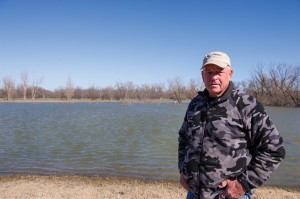Flooding is not a new problem for Fort Worthians, but careful planning, Marshall said, has protected downtown from a catastrophic flood for decades. Many of the worst floods in the city’s history occurred in the early part of the last century.
Downtown Fort Worth was hit with historic levels of flooding in 1908, 1922, and 1949, prompting the city and the Army Corps to build the current system of levees. While they have prevented further downtown flooding, Marshall said, they also have eliminated natural valley storage and pushed flood waters eastward.
Newell told me that building along any part of the Trinity River is a healthy use of underutilized North Texas land.
“As the Metroplex grows, it is getting away from its core,” Newell said, with “core” meaning city centers. “That expansion taxes transportation and utilities. Utilizing a piece of property inside the loop is very good for the city and the community. People can live closer to where they work and spend less time on the roads. There are a lot of reasons it makes sense.”
As has been observed by Amendola and some of her neighbors, including Mary Kelleher, a TRWD board member, nearby construction in and around Trinity Lakes, including on real estate owned by Chesapeake Energy, has elevated the land immediately north of the Trinity River considerably. Amendola, Kelleher, and some of their neighbors believe the construction can potentially redirect flood waters southward, toward Amendola’s ranch and environs.
Amendola, Kelleher, and some of their neighbors also claim they have not received adequate help with flood mitigation from the Army Corps and the TRWD. The TRWD’s Marshall, when asked, said several projects in the works will significantly improve flood controls in the area.
The flooding, he went on, might not be the result of the commercial development nearby but commercial development throughout the region. Loss of valley storage all along the Trinity and increased drainage from streets and roads top his list of suspects. Amendola, Kelleher, and some of their neighbors also suspect that the controlled releases from area lakes by TRWD and the Corps are a big part of the problem.
For residents living near the Trinity in East Fort Worth, the controlled releases come from three sources: Eagle Mountain Lake, Lake Benbrook, and Lake Worth.
TRWD manages releases from Eagle Mountain Lake, while the Corps oversees releases from Lake Benbrook. Lake Worth is a passive reservoir, Marshall said, meaning it is designed to spill over at a predetermined height. Releases from Eagle Mountain Lake and Lake Benbrook have occurred since the lakes were constructed in the early to middle part of the 20th century.
“We release from Eagle Mountain, or any of our reservoirs for that matter, anytime the lake rises above” safe levels, said TRWD spokesperson Chad Lorance, adding that the state sets the levels.
In 2015, the TRWD released 780,000 acre-feet from Eagle Mountain Lake.
“One acre foot is roughly [the volume of] a football field one foot deep in water,” Lorance said.
The year before, he added, Eagle Mountain Lake had zero water releases.
Kelleher believes that releases from the three lakes adversely and disproportionately affect residents east of Handley Ederville Road, near Amendola’s ranch. The reason, she added, is twofold: Handley Ederville marks the location of the city’s last levee, a fact confirmed by the TRWD’s Marshall, as the Trinity flows eastward, the river becoming narrower and curving drastically, sometimes northward and other times southward, while meandering toward the west near Newell’s developments. Secondly, Kelleher believes that during water releases, the part of the river near her neighborhood receives “more water in a narrower space that can’t accommodate it.”
According to TRWD documents, sustained water releases from Eagle Mountain Lake the day before, during, and after the flood hit Amendola’s ranch peaked at 11,326 cubic feet per second.
“That is a fairly large release,” said Michael Wellbaum, who has been designing municipal and private infrastructure with Westra Consultants, an Arlington civil engineering firm, since 2015, in addition to working for decades for other engineering companies. “That equates to about 5,000,000 gallons per minute.”
For comparison, he said, the MillerCoors brewery in Fort Worth uses “half that amount” per day for brewing thousands of containers of beer.
To mitigate “much” of the flooding problems along the Trinity’s floodplain, Marshall said, his crew and members of Fort Worth’s Stormwater Management Division are finalizing a comprehensive plan that will increase valley storage in Central and East Fort Worth. The project, he said, is designed to address concerns from area residents. Construction of a levee near Beach Street in East Fort Worth began recently and should be completed in the next three to four years.
Residents along the floodplain on the East Side know one thing: If public policy doesn’t change soon, a catastrophic flood could put hundreds of lives –– and, according to the city, an estimated $1.5 billion worth of property –– in jeopardy.
******
Fort Worth Fire Department records show a sharp spike in the number of high-water investigations and water rescues throughout Fort Worth between 2013 and 2015. While 2013 and 2014 saw an average of 13 high-water investigations and zero water rescues, there were 79 high-water investigations and an unprecedented 18 flood-related rescues last year. Most of the 2015 incidents occurred outside of the record spring rainfall. For comment on the surge, the fire department’s communications officer, Kyle Falkner, referred me to city officials.
Linda Stern, the stormwater division’s communications officer, said the uptick was due to record rainfall last year which was compounded by a previous “long period” of drought, a period, according to the U.S. Drought Monitor, a collaboration among four federal agencies, that began in 2010 and ended last year.
The full lakes then backed up into low-lying areas, Stern said, and the saturated land was unable to absorb further rainfall.

Kelleher and husband Larry Langston were equally shocked by the unusually rapid swelling of the Trinity River last November. Langston and Kelleher lost several of their rabbits, chickens, and guinea hens.
Langston, a 66-year-old Vietnam War veteran who grew up a few miles from his current farm on Randol Mill Road, believes Newell’s companies are at least partly responsible. All of the dump trucks and bulldozers just a few blocks on the floodplain to the northeast of his house, kicking up dust and motoring past relentlessly, have Langston dreading the worst: that Newell’s development company is elevating the land to build on it.
When I asked Newell how he documents any loss of valley storage while elevating land in a floodplain, he said that his projects are monitored by the Army Corps while his staffers conduct all of the necessary reporting.
The Corps’ Church said his group does indeed closely monitor the area and is familiar with Newell’s developments near Trinity Lakes.
“When the project is reaching completion,” Newell said, “it’s surveyed by surveyors and reported back to the city and the Corps.”
The reports, he added, are also turned over to the Federal Emergency Management Agency, the group tasked with managing flood risk before a developed parcel of land can officially be said to be “out of [a] floodplain.”
“Have you ever undertaken any projects without proper permitting?” I asked.
“No, sir,” Newell said. “We’ve been following a plan [for Trinity Lakes] that’s been in existence since 1991.”
According to city documents and interviews with several local officials, Langston and company might not have been the only ones possibly affected by Newell’s projects. Tarrant County taxpayers might also have been. The TRWD, Marshall said, spent $1.2 million “repairing erosion, vegetation, fencing, and dredging” to bring one of Newell’s past projects up to proper standards. That project? A levee.
On June 24, 1985, one of Newell’s companies, RiverBend West, was issued a permit by the Army Corps to “construct a levee” to reclaim a portion of the floodplain now taken up by Newell’s RiverBend Estates.
Though Newell’s company was scheduled to finish the levee “sometime in the late 1980s,” said Marshall, who admitted his records aren’t quite clear, the TRWD took over ownership of the 1.3 mile-long structure shortly before its completion. RiverBend West was unable to finish the task. Why? The records aren’t clear, Marshall said.
The levee was about “90 to 95 percent” complete when TRWD took over ownership, said Marshall, noting that the TRWD had always planned to take over the project.
Newell’s recollection largely matches Marshall’s.
A permit to build the RiverBend West levee was “issued in 1984,” Newell said, “and the levee was certified complete in either 1987 or 1988. The levee was conveyed to [TRWD] before the project was completed.”
All of Newell’s projects, Davis said, are in compliance with city requirements.
******












The impact of the flooding at Trinity River Farm cannot be understated. My son, 10, has Autism, and has been taking riding lessons at Trinity River Farm for a year. He has changed dramatically, and developed a confidence I’ve never seen in him before. Miss Julie’s farm has been a major factor in his recent growth and development. The programs she runs benefit so many people in this community, and we would be devastated if it were to happen again, or something were to happen to the horse we are leasing from Miss Julie.
If Mr. Newell would like to make a positive impact on the community, he could consider sponsoring some of the local school children living in the apartments on Randol Mill to take riding lessons. He would be giving them the opportunity to be outdoors and develop equestrian skills. …Or he could stop building up the land directly north of the farm, thus pushing the water south of the river, impacting not only Miss Julie’s farm, but my community in Bentley Village.